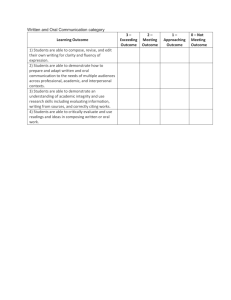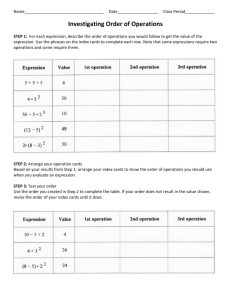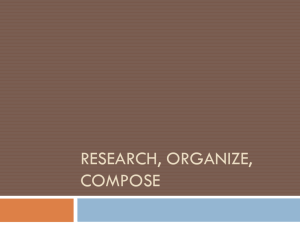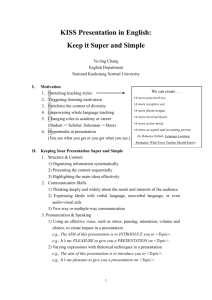Continuity in a School Music Program
advertisement
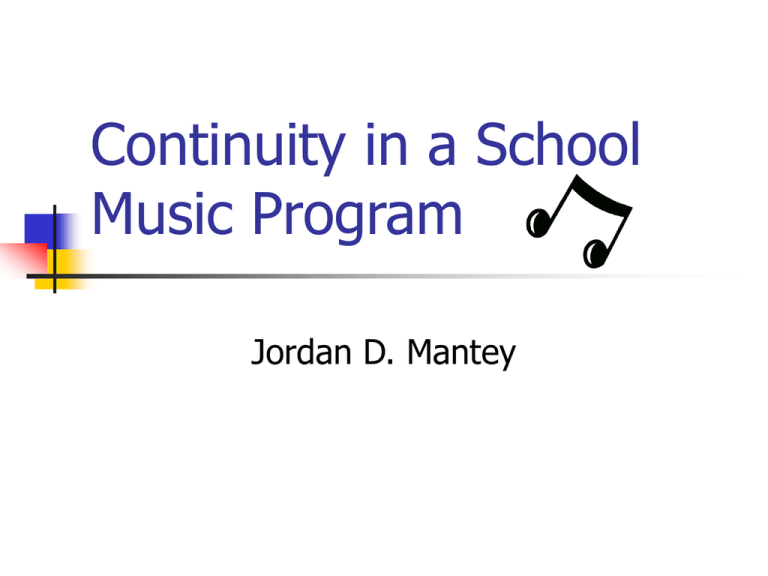
Continuity in a School Music Program Jordan D. Mantey Questions Why is consistency important in a music program? What expectations do we have as educators for a student once he or she has completed the music program? How do teachers impact continuity? Where can changes be made to allow for smoother transitions in a music program? Why consistency is important The best learning is a building process If knowledge is meaningfully related to prior knowledge, it will be retained “If we completely ignore everything from earlier years, we are not building upon a foundation, we are just providing random experiences” Instead of having to “start over” year after year, teachers can build upon material that the previous teacher has taught Teachers must think about what is meaningful to students The lack of consistent continuity is one of the reasons why music is kept defined as a “special” area rather than a curricular one Expectations (Standards) What a student should be proficient at after progressing through a music program 1. 2. 3. 4. 5. 6. 7. 8. 9. Singing, alone and with others, a varied repertoire of music Performing on instruments, alone and with others, a varied repertoire of music Improvising melodies, variations, and accompaniments Composing and arranging music within specified guidelines Reading and notating music Listening to, analyzing, and describing music Evaluating music and music performances Understanding relationships between music, the other arts, and disciplines outside the arts Understanding music in relation to history and culture How teachers can impact continuity Smooth Transitions All aspects of the standards should be present at every grade level to reach expectations when a student completes the music program Gradual movement to/from each grade level is very important Individual teacher philosophies can create a problem when communication among teachers is not present “K – 12 crescendo” Crescendo – a gradual increase in volume The K – 12 Crescendo As a student progresses in the program, more details of each standard should be presented Basic ideas should expand to include in-depth coverage of material and techniques Concepts should be revisited with greater depth and sophistication each year Students should be continually immersed in a wide range of musical experiences starting in kindergarten – those experiences should gradually increase in intensity through high school and beyond The K – 12 Crescendo •All standards are present at all points in this timeline •Detail becomes greater as a student progresses reading analyzing performing composing singing listening Ways to create smoother transitions between grade levels Conversations should be made among the music teachers The design of the curriculum should include a standards-based system of transitions Teachers can know what material the students are coming to them with Curriculum needs to flow K – 12 and be developed as a K – 12 curriculum and not within specific areas of study (general music, band, vocal) Material needs to be reinforced and revisited from year to year Take the same concepts and ideas and revisit them with greater depth and sophistication Standard 4 Composing and Arranging This standard allows students to become creatively involved in music Students automatically compose at their own level (there is no single “correct” answer) This standard is more sensitive to individual differences than the others This standard is not as valuable unless it is tied to the evaluation/analysis standards Students need to make critical judgments about their own compositions and those of their peers Notice how the standards get more detailed from one level to the next Kindergarten – 4th Grade Create and arrange music to accompany readings or dramatization Create and arrange short songs and instrumental pieces within specified guidelines Use a variety of sound sources when composing K – 4th grade composition Early grades will not be notating yet Compositions will have to be tape recorded or notated by the teacher Learning composition as a class Modeling/composing as a class is helpful in introducing the idea 5th Grade – 8th Grade Compose short pieces within specified guidelines, demonstrating how the elements of music are used to achieve unity and variety, tension and release, and balance Arrange simple pieces for voices or instruments other than those for which the pieces were written Use a variety of traditional and nontraditional sound sources and electronic media when composing and arranging 5th – 8th grade composition More advanced composition and use of notation Integration of other standards Standard 5 (reading and notating music) becomes more important in recording compositions Standards 6 and 7 (analyzing and evaluating music) become crucial in describing compositions and taking part in self-evaluations of compositions Composition in small groups or individually 9th Grade – 12th Grade Compose music in several distinct styles, demonstrating creativity in using the elements of music for expressive effect Arrange pieces for voices or instruments other than those for which the pieces were written in ways that preserve or enhance the expressive effect of the music Compose and arrange music for voices and various acoustic and electronic instruments, demonstrating knowledge of the ranges and traditional usages of the sound sources Compose music, demonstrating imagination and technical skill in applying the principles of composition 9th – 12th grade composition Detailed notation and use of expression Relationships between own performance and composition Highly individualistic Full integration of standards Students can see a connection between their own compositions and the expression they perform with There is a strong usage of standards in completing a composition Prior composing experience definitely plays a positive role My Conclusions Students need a sequential music program The best learning is a building process The K – 12 crescendo provides a good example of the increase of depth and sophistication from kindergarten to 12th grade Continual communication among teachers is vital The brain remembers information better when it can draw upon prior knowledge to make a meaningful connection Teachers must discuss curriculum and make decisions that can be universal across it This is true of any discipline, not only music Expectations must be clear The National Standards should provide a framework for expectations, but they should not be the sole foundation for them Transitions from grade to grade can be made smoother by knowing expectations at the beginning of a student’s journey in a school music program The “K – 12 crescendo” idea provides an effective way to include concepts throughout K – 12 and expanding on them more and more each year References Kerchner, Jody L. “Incorporating the National Standards in Performance Classes.” Teaching Music August 2001: 40-44. Ormrod, Jeanne E. Educational Psychology: Developing Learners. Prentice Hall, 1997. Taggart, Cynthia C. Personal interview. 28 Mar. 2003. Wells, Richard. "Designing Curricula Based on the Standards." Music Educators Journal July 1997: 34-39. The School Music Program: A New Vision. MENC. 28 Mar. 2003 http://www.menc.org/publications/books/prek12st.html. Any Questions?
